
Overview: While reading the story "Seven Fat Cats", students will listen and match the sounds (rhyming, beginning, ending, and vowel.)
- Subject:
- English Language Arts
- Speaking and Listening
- Material Type:
- Lesson Plan
- Date Added:
- 05/12/2021

Overview: While reading the story "Seven Fat Cats", students will listen and match the sounds (rhyming, beginning, ending, and vowel.)
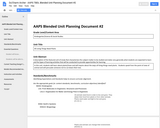
In this unit, students will learn about plants/trees and will inquire about the ways all living things need plants. Students speak from the point of view of animal and will persuade someone not to cut down their tree.
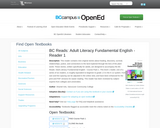
This reader contains nine original stories about healing, discovery, survival, relationships, justice, and connections to the land explored through the lens of the plant world. These stories, written specifically for adults, are designed to accompany the BC Reads: Adult Literacy Fundamental English - Course Pack 1. This level 1 reader, one of a series of six readers, is roughly equivalent to beginner to grade 1.5 in the K-12 system. Font size and line spacing can be adjusted in the online view, and have been enhanced for the print and PDF versions for easier reading. This reader has been reviewed by subject experts from colleges and universities.
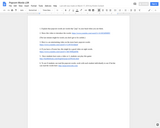
There is often a lot of confusion on when to use good vs well. This lesson will clear up the confusion! Students will watch a youtube video on this, play a game, and end the lesson with a writing assignment where they will show their mastery of the concept.
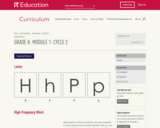
The instructional practices listed below summarize the instruction that accompanies the skills that are being taught in this cycle for the respective grade level. Teachers should review these routines for guidance on how to teach the skills and patterns reflected in the microphase.
Lessons 11-12, 14-15
Letter-Sound Chant: Students chant the names of letters and accompanying letter sounds in this ongoing routine (used in multiple lessons throughout a cycle) that reinforces taught graphemes (letter) and phoneme (sound) connections and keywords. This chant connects the keywords and phonemes in students' memories to support quick recall of phonemes for decoding and encoding.
Lesson 11
Poem Launch: Students hear/read a poem that includes keywords for each letter introduced in the cycle. The verses incorporate new high-frequency word(s) and words that feature the cycle's new graphemes (letters) and phonemes (sounds). This poem is used throughout the cycle for different purposes.
Getting to Know the Letters (Part 1): Students "meet" each new letter for the cycle, exploring the following about each: it's name (grapheme), its sound(s) (phoneme), and a consistent keyword that represents the letter. This practice includes a Letter-Sound chant component (see Opening Instructional Practices for more details), using only the newly introduced letters.
Lesson 12
Getting to Know the Letters (Part 2): Students use the same letters as in Part 1, but now get to know the shape and formation of each, practicing first with their bodies and then on paper.
Lesson 13
Mystery Word (Clues to the Mystery Word and Introducing the Mystery Word): Students explore the already introduced poem for a new purpose: searching for a "mystery" high-frequency word. Students are given clues about the number of letters in the word and then search for words with the same number of letters, encouraging student inquiry. They also listen for a word as the teacher reads the words of the poem, clapping when they hear it. This practice is a vehicle for introducing Kindergarten high-frequency words that students will later see in poems and Decodable Student Readers.
Lesson 14
Feel the Beats: Students explore the already introduced poem for a new purpose: to listen for and identify each syllable (beat) in a spoken word. They count the number of syllables in the spoken word, pronounce each one, and manipulate them by segmenting and blending. (Note: Starting in Module 3, this Work Time instructional practice transitions to a shorter, Opening practice.)
Lesson 15
Rhyme Time: Students explore the already introduced poem for a new purpose: identifying rhyming words. They begin with a game that provides an introduction to the concept of rhyming and then revisit the poem, listening for words that rhyme (have the same ending sound). Rhyming develops this phonemic awareness, teaching students to group words together according to larger sound units. Rhyme Time guides students to analyze sounds in spoken words.
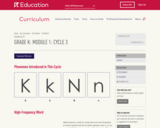
ELA GK:S1:C3
GRADE K: MODULE 1: CYCLE 3
ELA GK:S1:C2:L15
ELA GK:S1:C3:L16
In this Cycle
Lessons
You are here:
ELA Grade K
ELA GK:S1
ELA GK:S1:C3
Like what you see?
Order printed materials, teacher guides and more.
How to order
Help us improve!
Tell us how the curriculum is working in your classroom and send us corrections or suggestions for improving it.
Leave feedback
Download Materials
Phonemes Introduced in This Cycle
K
K
k
k
N
N
n
n
High-Frequency Word
the
High-frequency words are words that occur most frequently in written material and do not follow phonetic rules or, as we say in the EL Education curriculum, "don't play fair." Due to this fact, it is important that students are able to navigate these words with ease to improve their reading fluency and comprehension. While high-frequency words on their own don't carry much meaning, they are essential to sentences and help students gather meaning. Below you will find five activities for each day of the week that teachers can do with students or parents can do with their children at home as high-frequency words are being introduced cycle by cycle.
Read it, say it, write it, read it again
Use high-frequency words in sentences (oral and written)
Read a list of high-frequency words and time yourself on fluency (keep running list)
Search for high-frequency words in sentences/poems and underline them
Fishing for high-frequency words (one person reads the word aloud, other students find the word in a stack of other high-frequency words)
Instructional Practices
The instructional practices listed below summarize the instruction that accompanies the skills that are being taught in this cycle for the respective grade level. Teachers should review these routines for guidance on how to teach the skills and patterns reflected in the microphase.
Lesson 16
Poem Launch: Students hear/read a poem that includes keywords for each letter introduced in the cycle. The verses incorporate new high-frequency word(s) and words that feature the cycle's new graphemes (letters) and phonemes (sounds). This poem is used throughout the cycle for different purposes.
Getting to Know the Letters (Part 1): Students "meet" each new letter for the cycle, exploring the following about each: its name (grapheme), its sound(s) (phoneme), and a consistent keyword that represents the letter. This practice includes a Letter-Sound chant component (see Opening Instructional Practices for more details), using only the newly introduced letters.
Lesson 17
Poem Letter Search: Students explore the already introduced cycle poem for a new purpose: to search for specific letters.
Getting to Know the Letters (Part 2): Students use the same letters as in Part 1, but now get to know the shape and formation of each, practicing first with their bodies and then on paper.
Lesson 18
Mystery Word (Clues to the Mystery Word and Introducing the Mystery Word): Students explore the already introduced poem for a new purpose: searching for a "mystery" high-frequency word. Students are given clues about the number of letters in the word and then search for words with the same number of letters, encouraging student inquiry. They also listen for a word as the teacher reads the words of the poem, clapping when they hear it. This practice is a vehicle for introducing Kindergarten high-frequency words that students will later see in poems and Decodable Student Readers.
Lesson 19
Feel the Beats: Students explore the already introduced poem for a new purpose: to listen for and identify each syllable (beat) in a spoken word. They count the number of syllables in the spoken word, pronounce each one, and manipulate them by segmenting and blending. (Note: Starting in Module 3, this Work Time instructional practice transitions to a shorter, Opening practice.)
Lesson 20
Rhyme Time: Students explore the already introduced poem for a new purpose: identifying rhyming words. They begin with a game that provides an introduction to the concept of rhyming and then revisit the poem, listening for words that rhyme (have the same ending sound). Rhyming develops this phonemic awareness, teaching students to group words together according to larger sound units. Rhyme Time guides students to analyze sounds in spoken words.
Lessons 17, 19-20
Letter-Sound Chant: Students chant the names of letters and accompanying letter sounds in this ongoing routine (used in multiple lessons throughout a cycle) that reinforces taught graphemes (letter) and phoneme (sound) connections and keywords. This chant connects the keywords and phonemes in students' memories to support quick recall of phonemes for decoding and encoding.
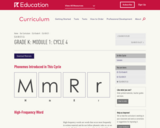
The instructional practices listed below summarize the instruction that accompanies the skills that are being taught in this cycle for the respective grade level. Teachers should review these routines for guidance on how to teach the skills and patterns reflected in the microphase.
Lesson 21
Poem Launch: Students hear/read a poem that includes keywords for each letter introduced in the cycle. The verses incorporate new high-frequency word(s) and words that feature the cycle's new graphemes (letters) and phonemes (sounds). This poem is used throughout the cycle for different purposes.
Getting to Know the Letters (Part 1): Students "meet" each new letter for the cycle, exploring the following about each: its name (grapheme), its sound(s) (phoneme), and a consistent keyword that represents the letter. This practice includes a Letter-Sound chant component (see Opening Instructional Practices for more details), using only the newly introduced letters.
Lesson 22
Poem Letter Search: Students explore the already introduced cycle poem for a new purpose: to search for specific letters.
Getting to Know the Letters (Part 2): Students use the same letters as in Part 1, but now get to know the shape and formation of each, practicing first with their bodies and then on paper.
Lesson 23
Mystery Word (Clues to the Mystery Word and Introducing the Mystery Word): Students explore the already introduced poem for a new purpose: searching for a "mystery" high-frequency word. Students are given clues about the number of letters in the word and then search for words with the same number of letters, encouraging student inquiry. They also listen for a word as the teacher reads the words of the poem, clapping when they hear it. This practice is a vehicle for introducing Kindergarten high-frequency words that students will later see in poems and Decodable Student Readers.
Lesson 24
Feel the Beats: Students explore the already introduced poem for a new purpose: to listen for and identify each syllable (beat) in a spoken word. They count the number of syllables in the spoken word, pronounce each one, and manipulate them by segmenting and blending. (Note: Starting in Module 3, this Work Time instructional practice transitions to a shorter, Opening practice.)
Lesson 25
Rhyme Time: Students explore the already introduced poem for a new purpose: identifying rhyming words. They begin with a game that provides an introduction to the concept of rhyming and then revisit the poem, listening for words that rhyme (have the same ending sound). Rhyming develops this phonemic awareness, teaching students to group words together according to larger sound units. Rhyme Time guides students to analyze sounds in spoken words.
Lessons 21-22, 24-25
Letter-Sound Chant: Students chant the names of letters and accompanying letter sounds in this ongoing routine (used in multiple lessons throughout a cycle) that reinforces taught graphemes (letter) and phoneme (sound) connections and keywords. This chant connects the keywords and phonemes in students' memories to support quick recall of phonemes for decoding and encoding.
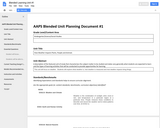
This unit will focus on weather. Students will explore what weather is, how weather is measured and how weather impacts living things.

This guidance document helps teachers understand the why, as well as the concrete what and how, of the K-2 Reading Foundations Skills Block: the overall structure, how time is used within the hour of instruction, what students do during Whole Group instruction and during differentiated Small Group instruction and Independent work, how the design of the Skills block reflects grade level reading and language standards, what assessments look like, how the K-2 Skills Block supports and complements the work from the K-2 Language Arts Curriculum (module lessons and Labs), what a day in the Skills Block looks like, and Frequently Asked Questions.
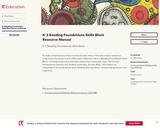
A single comprehensive resource that includes many of the documents needed to understand the design and to effectively implement the K-2 Reading Foundations Skills Block, including assessment overview, assessment conversion chart, Benchmark Assessments (teacher and student materials), Activity Bank, information on independent and small group work, syllabification guidance, handwriting guidance, and a glossary.
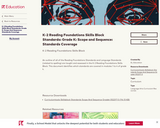
An outline of all of the Reading Foundations Standards and Language Standards (related to spelling) are taught and assessed in the K-2 Reading Foundations Skills Block. This document identifies which standards are covered in modules 1 to 4 of grade 2.

This document provides a high-level overview of the Common Core State Standards, substandards, and associated EL-created learning targets explicitly taught and formally assessed in each of the four modules for a given grade level of the K-2 Reading Foundations Skills Block.
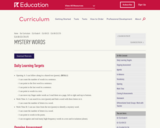
Opening A: I can follow along in a shared text (poem). (RF.K.1)
I can count the number of words in a sentence.
I can point to the first word in a sentence.
I can point to the last word in a sentence.
I can point to words in a text.
I can move my finger under words as I read them on a page, left to right and top to bottom.
Work Time A: I can search in a text (poem) and find a word with three letters in it.
I can count the number of letters in a word.
Work Time B: I can use clues from the text (poem) to identify a mystery word.
I can count the number of letters in a word.
I can point to words in the poem.
I can recognize and read many high-frequency words in a text and in isolation (alone).

Opening A: I can follow along in a shared text (poem). (RF.K.1)
I can count the number of words in a sentence.
I can point to the first word in a sentence.
I can point to the last word in a sentence.
I can point to words in a text.
I can move my finger under words as I read them on a page, left to right and top to bottom.
Work Time A: I can search in a text (poem) and find a word with two letters and three letters in it.
I can count the number of letters in a word.
Work Time B: I can use clues from the text (poem) to identify a mystery word.
I can count the number of letters in a word.
I can point to words in the poem.
I can recognize and read many high-frequency words in a text and in isolation (alone).
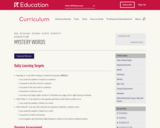
Opening A: I can follow along in a shared text (poem). (RF.K.1)
I can count the number of words in a sentence.
I can point to the first word in a sentence.
I can point to the last word in a sentence.
I can point to words in a text.
I can move my finger under words as I read them on a page, left to right and top to bottom.
Work Time A: I can search in a text (poem) and find a word with two letters in it.
I can count the number of letters in a word.
Work Time B: I can use clues from the text (poem) to identify a mystery word.
I can count the number of letters in a word.
I can point to words in the poem.
I can recognize and read many high-frequency words in a text and in isolation (alone).
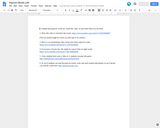
Through this lesson, students will be exposed to a variety of basic sight words or "popcorn" words. First they will watch a variety of videos to be introduced to the words. Then they will play a fun game on popcorn words. To end the lessons, students will identify their popcorn words.
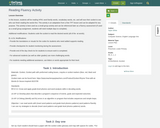
In this lesson, students will be reading HFW, word family words, vocabulary words, etc. and will race their ozobot to see who can finish reading the words first. This activity is an adaptation from a free TPT lesson and can be adapted for any purpose. This activity is best used as a small group activity and can be referenced later as a fluency assessment (If used as a small group assignment, students will need multiple days to complete).Additional modifications: Students code the ozobot to read the desired words (all of the -at words).EL & DL Modifications:- Provide the translations or visuals for the codes for students who need added supports reading.- Provide checkpoints for student monitoring during the assessment.- Provide end of the day check-ins for students to ensure work is completed.- For advanced students (as well as older grades) use more challenging words.- For students needing additional assistance, use letters or words appropriate for their level.
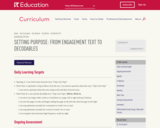
Opening A: I can retell events from the story "Chip Can't Nap!"
Work Time A (optional): Using evidence from the text, I can answer questions about the story "Chip Can't Nap!"
I can answer questions about the story using words and ideas from the story.
Work Time B: I can read the decodable text "Chip Can't Nap!" (RF.K.1 RF.K.3)
I can move my finger under words as I read them on a page, left to right and top to bottom.
I can turn the pages in order and begin reading the page on the left side, then the page on the right.
I can map phonemes (sounds) for consonants in words I see or read.
I can map phonemes (sounds) for vowels in words I see or read.
I can recognize and read many high-frequency words by sight.
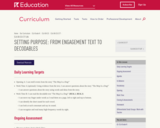
Opening A: I can retell events from the story "The Mop Is a Dog!"
Work Time A (optional): Using evidence from the text, I can answer questions about the story "The Mop Is a Dog!"
I can answer questions about the story using words and ideas from the story.
Work Time B: I can read the decodable text "The Mop Is a Dog!" (RF.K.1, RF.K.3)
I can move my finger under words as I read them on a page, left to right and top to bottom.
I can identify the short sound for each vowel.
I can look at each consonant and say its sound.
I can recognize and read many high-frequency words by sight.
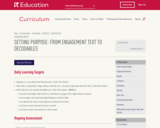
Opening A: I can retell events from the story "Josh's New Home."
Work Time A (optional): Using evidence from the text, I can answer questions about the story "Josh's New Home."
Work Time B: I can read the decodable text "Josh's New Home." (RF.K.3)
I can move my finger under words as I read them on a page, left to right and top to bottom.
I can recognize and read many high-frequency words by sight.
I can identify the name of each uppercase and lowercase letter.
I can look at each consonant and say its sound.
I can look at each vowel and say its short sound.